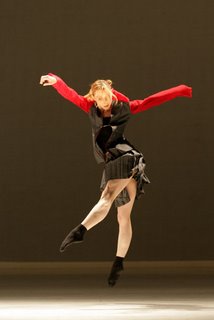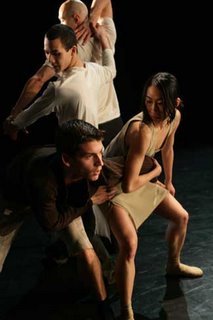
Sister Fury - Ed Wubbe
Apresenta três mulheres que querem libertar-se do seu isolamento.

The Green - Ed Wubbe
Uma comparação da magnitude de "Paixão Segundo S. João", de Bach, com a insignificância do homem.

Wilsonians - Ed Wubbe
Uma peça em ritmo acelerado com rápidas mudanças de cenário.

Fo(4)r - Georg Reischl
(para quatro bailarinos)
Âffi by Marco Goecke
(também uma peça rápida e expressiva)
e
Geeekspeak by Stephen Shropshire
(inspirada na dinâmica de grupo).
23 e 24 de Junho, Festival de Sintra
_______
SISTER FURY
Coreografia: Ed Wubbe
Música: J.S. Bach
Figurinos: Pamela Homoet
Iluminação: Benno Veen / Ed Wubbe
Cenário: Ed Wubbe and Amber Heij (AMMO)
Vídeo: Amber Heij (AMMO)
Estreia: 8 de Abril de 2004, Stadsschouwburg Amsterdam
Duração: 14m
ÄFFI
Coreografia: Marco Goecke
Música: Johnny Cash
Figurinos: Michaela Springer
Iluminação: Udo Haberland
Estreia: Junho de 2005, Musis Sacrum/Schouwburg Arnhem
Duração: 10m
THE GREEN
Coreografia: Ed Wubbe
Música: J.S. Bach (Abertura da Paixão Segundo S. João)
Figurinos: Pamela Homoet
Iluminação: Mark Truebridge
Cenografia: Ed Wubbe
Estreia: 15 de Fevereiro de 2006, Rotterdamse Schouwburg
Duração: 20m
GEEKSPEAK
Coreografia: Stephen Shropshire
Música: Pamela Z, Geekspeak
Figurinos: Stephen Shropshire
Iluminação: Stephen Shropshire / Aram Visser
Estreia: 11 de Junho de 2006, Rotterdamse Schouwburg
Duração: 10m
FO(4)R
Coreografia: Georg Reischl
Música: Michiel Jansen
Iluminação e Figurinos: Georg Reischl
Estreia: 15 de Fevereiro de 2006, Rotterdamse Schouwburg
Duração: 18m
WILSONIAN
Coreografia: Ed Wubbe
Música: Der BlutHarsch, Kenny Larkin
Figurinos: Pamela Homoet
Iluminação: Benno Veen
Estreia: 2 de Junho de 2005, Rotterdamse Schouwburg
Duração: 16m
_______

Ed Wubbe
_______
Ed Wubbe once named Rameau and Kathleen as his essential ballets, because of their extreme, dramatic nature. They thereby mark the musical and theatrical lines along which his work unfolds.
RAMEAU represents the dancing-to-music line, which he initiated in ballets set to Handel (Messiah) and Vivaldi (Nisi Dominus), both of which were sparkling choreographic works that accentuated the energy and dynamics of the music, and continued in Parts and Perfect Skin, set to Bach. However, something of the drama of Kathleen, which turned out to be the overture to a theatrical line, also lay dormant in Rameau. He combined his fascination for the cool, formal harpsichord music of the baroque composer Rameau with the last days of courtly music and thereby to the disenchantment of the French nobility waiting resignedly forthe guillotine. This explains why some of the dancers, slightly bored, watch the wilful duets and solos performed by dancers in leather jackets and sturdy boots.
In Rameau, Wubbe made a deep scratch in the gloss of the ballet aesthetics he had been given in his classical training and as a dancer and choreographer at the Nederlands Dans Theater and Introdans. Initially, he was still very much influenced by Kylian. White Streams, set to Arvo Part, was a successful example of a music ballet in which the continuous flow of movements in an organic dance idiom yielded a fine lyrical image. By contrast, his idiom became angular and sharp when he worked with the classical dancers of the Scapino Ballet and learned to make use of their dancing in ballet slippers, as in Nisi Dominus, Rameau, Parts and Perfect Skin.
KATHLEEN was a real turning-point, as an intense dance ritual set to pop music by Godflesh, with vivacious trios, aggressive group dances and a gripping male solo. This was a powerful work that displayed a pessimistic nihilism on which it made implicit comment. This contemporary West Side Story was also a statement by a choreographer who had been able to free himself entirely from the tradition that had characterised the Scapino youth ballet company since its founding in 1945. No subsequent ballet was as furious as Kathleen.
Even his LE SACRE DU PRINTEMPS was a refined combination of dance, music, light and set, for which he deliberately chose not Stravinsky's violent orchestral work but Maarten Bon's subtle adaptation for pianos.
His theatrical work was cerebral rather than compelling, and was impressionist in tone as a result of its light dance idiom and associative storyline. For example, he set ROMEO & JULIA to an amalgam of non-western music - love songs - and concentrated the story into twelve scenes. Writings by Shakespeare, Yourcenar, Da Vinci and Marinetti touched upon the original love tragedy. The love duet - the balcony scene - was a particularscorcher, afterwhich the vengeful Tybalt made sure the burning love charred into a pile of smouldering ash.
THE SCHLIEMANN PIECES focussed on the passion with which the amateur archaeologist Schliemann once sought Troy. Excerpts from his diary and from the Iliad were quoted. Apart from Schliemann, the Greek beauty Sophia was also identifiable as a character.
The leading character's feverish quest seemed to represent the equally single-minded way Wubbe sought a formula for making theatrical work that was not predictable. He was more successful atthis in NICO, about the life and music of the legendary singer. lts great asset was the music specially composed by John Cale, a member of The Velvet Underground at the time and a former lover of Nico's. Cale's music was alternated with songs by Nico on tape. One could follow the course of Nico's life in the danced scènes, without resort to anecdote: the Chelsea Girl in New York who created a furore with her organ and seasoned singing in the seventies, until her sojourn and death on Ibiza. This piece, where music, dance and drama were all of a piece, was made especially gripping by the performance of Beth Bartholomew.
ROSARY was a successful example of the new style of music ballet. It was a sparkling group work that playfully and organically translated the emotions from Schubert's String Quartet in C. With thanks to the dancers, who creamed off the articulated movements of the legs and fitful turns of the torso and in their stock-inged feet made them appear feather-light. An utterly lyrical ballet that nevertheless did not come across as overly fragrant and in which hè proved his mature ability as a creator of pure dance constructions and duets.
As a modern choreographer and leader of the leading Scapino company, now brought up to date, Wubbe wants to establish links with other disciplines and art institutions in Rotterdam. He has for example collaborated with Winy Maas of the MVRDV firm of architects. Using computer graphics, designers translated her stratified concept of'the stacked city' into a virtual stage set, a kaleidoscopic panorama of abstract images in which dancers performed like symbols of the human dimension. MANYFACTS, Life in the 30 City was about the interaction between anonymous and personal, abstraction and emotion. Wubbe wants to express this personal aspect in his dances.
His classically-based modern dance is nevertheless highly stylised, but this does not stop the dancers from making their own mark on it: in the past there were Charlotte Baines and Keith-Derrick Randolph, and now, together with Mischa van Leeuwen and Bonnie Doets there are another twenty-two high-quality expressive dancers.
Isabelle Lanz (2003)
Contemporary Dance in the Low Countries
Sem comentários:
Enviar um comentário